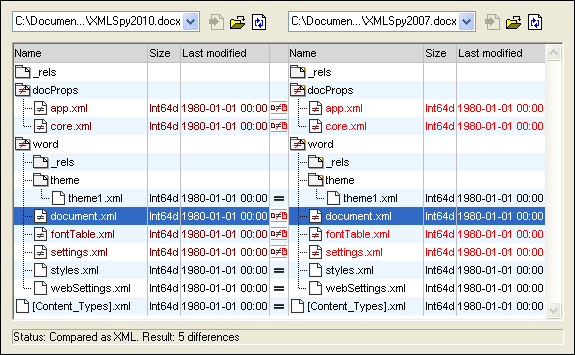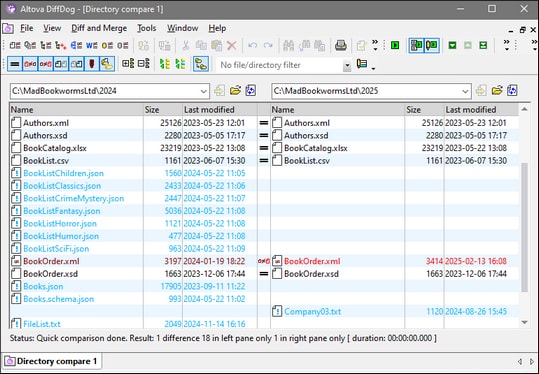Compare Directories
Altova website: ![]() Folder compare tool
Folder compare tool
In DiffDog, you can compare directories and, optionally, their sub-directories in the Directory Comparison window (illustrated below). Here you can compare, merge, and synchronize directories. There are two ways in which DiffDog compares directories:
•By comparing the sizes and timestamps of files in the directories. This comparison type is called Quick Comparison Mode.
•By comparing the contents of files in directories. This comparison type includes the following modes: the Text Comparison, XML Comparison, Binary Comparison, and Extensions Comparison modes.
How to compare directories
This subsection explains how to open a Directory Comparison window and select directories for comparison. Follow the instructions below.
1.Click the ![]() toolbar command. Alternatively, select the menu option File | Compare Directories. An empty Directory Comparison window will open.
toolbar command. Alternatively, select the menu option File | Compare Directories. An empty Directory Comparison window will open.
2.Select two directories to compare. You can use any of the methods described below.
Method 1: Select directories in Directory Comparison window
To select directories in the active Directory Comparison window, do one of the following in the relevant pane of the window:
oClick the  icon and select a directory in the Browse for Folder dialog box.
icon and select a directory in the Browse for Folder dialog box.
oEnter the full path of a directory and click the ![]() (Apply) button.
(Apply) button.
oSelect a previously compared directory from the drop-down list (screenshot below).

Method 2: Select directories in Windows Explorer
You can select two directories in Windows Explorer, right-click them and select Compare with Altova DiffDog from the context menu. This will open a new instance of DiffDog and display the selected folders in the Directory Comparison window.
Method 3: Open directories from a URL
You can open directories from a URL as follows:
1)Click  in the relevant pane of the Directory Comparison window. The Browse for Folder dialog box will appear.
in the relevant pane of the Directory Comparison window. The Browse for Folder dialog box will appear.
2)Click Switch to URL and provide the relevant connection details. For details, see Open Files from URLs.
Alternative method
Alternatively, you can select the menu option File | Open (Ctrl+O) and then follow the steps below:
1.Select Compare directories in the Open comparison dialog box.
2.Choose two directories to compare in the Content group. You can also open a directory from a URL through FTP, HTTP, or HTTPS. See Open Files from URLs.
3.Optionally, select a filter from the File/directory filter drop-down list.
4.Optionally, activate the Include subdirectories check box.
5.Click OK. A new Directory Comparison window containing the selected directories will open.
Start comparison
Irrespective of how you choose to open directories, comparison will start automatically unless you have deactivated the Autostart Comparison option in the Diff and Merge menu or the  command in the toolbar.
command in the toolbar.
For information about other aspects of directory comparison, see the following topics:
•Filtered Directory Comparison
ZIP and OOXML files
ZIP-conformant files are regarded as directories if the ZIP conformant file option is selected as the default file comparison mode for *.zip files on the File types tab of the DiffDog Options dialog (this is the default setting). You can then select a ZIP file as one of the directories in a directory comparison, show the content of a ZIP file if it appears as a file in a directory comparison, and also copy and merge files that are contained in the ZIP file.
Office Open XML (OOXML) files—which can be thought of as a specialized form of ZIP archives—are also opened for comparison in directory comparison windows. After the content of the OOXML file is displayed in the directory comparison window, you can browse for the document.xml file and open it in a file comparison window.

Context menus of files and folders
In the directory-comparison window, each file and folder have their respective context menus.
If you right-click a file, you can perform the following actions:
•Copy the file name
•Copy the file path
•Open the file location
•Open the file in an external application (e.g., if Altova XMLSpy is your default application for XML files, the file will open in this application)
If you right-click a folder, you can perform the following actions:
•Copy the folder's name
•Copy the full path of the folder
•Open the folder with its contents in Windows Explorer
